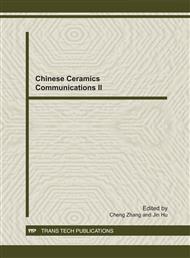p.13
p.17
p.21
p.25
p.32
p.36
p.40
p.44
p.49
Effect of TiCl4 Concentration and Acidity on Size and Phase of TiO2 Nanopowders Prepared by Non-Hydrolytic Sol-Gel Method
Abstract:
TiO2 nanopowders were synthesized by non-hydrolytic sol−gel method. Effects of TiCl4 concentration and acidity on the properties of TiO2 nanopowders were investigated. The results showed that the average grain size of TiO2 decreased with the increasing of TiCl4 concentration. H+ can inhibit the growth of TiO2 particles and Cl- is conducive to the formation of rutile phase. When 2.06M HCl was used as the reaction solution, TiO2 microspheres with diameter 2μm was obtained, and TiO2 microspheres was composed of anatase and rutile phase.
Info:
Periodical:
Pages:
32-35
Citation:
Online since:
November 2011
Authors:
Keywords:
Price:
Сopyright:
© 2012 Trans Tech Publications Ltd. All Rights Reserved
Share:
Citation:


